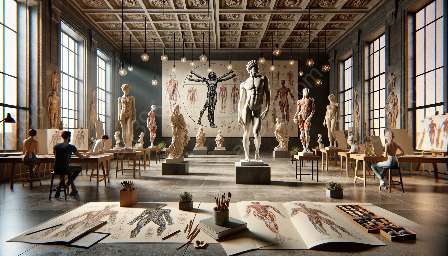Throughout history, different cultures have depicted human proportions in art in various ways, reflecting their unique artistic traditions, societal norms, and aesthetic preferences. Understanding the nuances of cultural variations in representing human proportions can provide insights into the diverse and rich tapestry of artistic expression across the globe. This topic is closely tied to the concept of artistic anatomy, which delves into the study of the human body's structure and proportions as represented in art.
The Significance of Human Proportions in Art
Human proportions play a fundamental role in art, serving as a cornerstone for creating realistic and visually appealing representations of the human form. Artists have long studied and observed human proportions, aiming to capture the essence of beauty, strength, and emotion through their artwork. The depiction of human proportions is intrinsically linked to cultural values, religious beliefs, and societal standards, shaping the artistic narratives and visual languages of different civilizations.
Cultural Variations and Regional Influences
Exploring cultural variations in the representation of human proportions reveals how different societies have interpreted and rendered the human form. From the idealized and harmonious figures of ancient Greek statues to the elongated and stylized depictions in African art, each culture has manifested its distinct perspective on human proportions through artistic expression. Regional influences, such as climate, geography, and historical events, have also contributed to the evolution of artistic anatomy and the portrayal of human proportions.
Artistic Anatomy: Bridging Science and Art
Artistic anatomy serves as a bridge between the scientific study of the human body and the artistic interpretation of its proportions. Drawing from anatomical studies, artists gain a deeper understanding of skeletal and muscular structures, enabling them to create more realistic and anatomically accurate representations. However, cultural variations in representing human proportions often transcend anatomical precision, encompassing societal ideals of physical beauty, gender dynamics, and spiritual symbolism.
Symbolism and Cultural Identity
The representation of human proportions in art often carries symbolic significance, reflecting cultural identity, mythological narratives, and ritualistic practices. From the idealized depictions of the human body in Renaissance art to the symbolic exaggerations found in Asian and Indigenous art forms, cultural variations in representing human proportions convey a profound connection to the respective societies' collective consciousness and belief systems.
Evolution and Contemporary Interpretations
In the context of contemporary art, the exploration of cultural variations in representing human proportions continues to evolve as artists engage with multicultural influences and reinterpret traditional norms. This dynamic interplay fosters a global dialogue on diversity, inclusivity, and the evolving perceptions of beauty and identity. As artistic anatomy intersects with cultural representations, contemporary artists navigate the complexities of human proportions in a rapidly changing world, challenging historical conventions and embracing a wide spectrum of cultural perspectives.
Conclusion
Understanding cultural variations in representing human proportions provides a compelling lens through which to appreciate the depth and diversity of human expression in art. By exploring the intricate interplay between cultural influences, artistic anatomy, and the significance of human proportions in art, we gain a deeper understanding of the rich tapestry of global artistic traditions and the evolving narratives of the human form.

